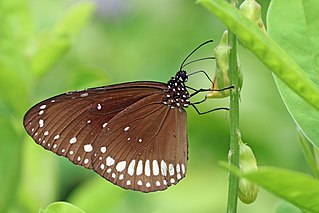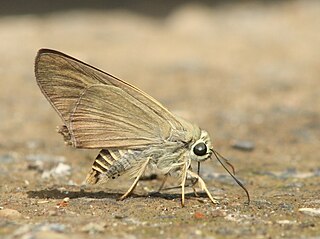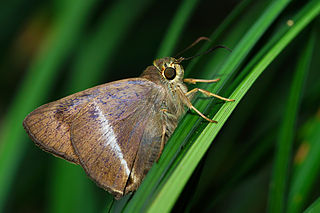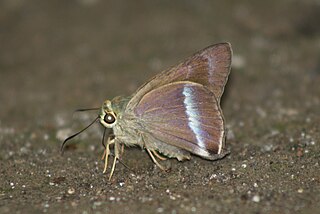
Euploea core, also known as the common crow, is a common butterfly found in South Asia to Australia. In India it is also sometimes referred to as the common Indian crow, and in Australia as the Australian crow. It belongs to the crows and tigers subfamily Danainae.

Tirumala limniace, the blue tiger, is a species of butterfly found in South Asia, and Southeast Asia that belongs to the brush-footed butterfly family, Nymphalidae. More specifically it is part of the crows and tigers or danaid group. This butterfly shows gregarious migratory behaviour in southern India. In some places, it may be found in congregations with Danaus genutia, Tirumala septentrionis, Euploea sylvester, Euploea core, Parantica aglea, and at high elevations, with Parantica nilgiriensis, on Crotalaria.

Leptosia nina, the psyche, is a small butterfly of the family Pieridae and is found in Indian subcontinent, southeast Asia and Australia. The upper forewing has a black spot on a mainly white background. The flight is weak and erratic and the body of the butterfly bobs up and down as it beats its wings. They fly low over the grass and the butterfly rarely leaves the ground level.

Papilio polytes, the common Mormon, is a common species of swallowtail butterfly widely distributed across Asia.

Badamia exclamationis, commonly known as the brown awl or narrow-winged awl, is a butterfly belonging to the family Hesperiidae. It is found in south and southeast Asia, Australia, and Oceania.

Hasora chromus, the common banded awl, is a butterfly belonging to the family Hesperiidae which is found in the Indian subcontinent, Southeast Asia and Australia.

Hasora taminatus, the white banded awl, is a butterfly belonging to the family Hesperiidae, which is found in Asia.

Hasora vitta, the plain banded awl, is a butterfly belonging to the family Hesperiidae which is found in India and parts of Southeast Asia.

Danielpalianosist, commonly known as the common spotted flat, is a species of butterfly belonging to the family Hesperiidae. It is a common butterfly generally found in the wet forested hills of southern Asia, from India and the Himalayas east through Indo-China. The upper surfaces of the wings are dark brown with white bands and small white spots towards the tip of the wings.

Danaus chrysippus, also known as the plain tiger, African queen, or African monarch, is a medium-sized butterfly widespread in Asia, Australia and Africa. It belongs to the Danainae subfamily of the brush-footed butterfly family Nymphalidae. Danainae primarily consume plants in the genus Asclepias, more commonly called milkweed. Milkweed contains toxic compounds, cardenolides, which are often consumed and stored by many butterflies. Because of their emetic properties, the plain tiger is unpalatable to most predators. As a result, its colouration is widely mimicked by other species of butterflies. The plain tiger inhabits a wide variety of habitats, although it is less likely to thrive in jungle-like conditions and is most often found in drier, wide-open areas.

Graphium doson, the common jay, is a black, tropical papilionid (swallowtail) butterfly with pale blue semi-transparent central wing bands that are formed by large spots. There is a marginal series of smaller spots. The underside of wings is brown with markings similar to upperside but whitish in colour. The sexes look alike. The species was first described by father and son entomologists Cajetan and Rudolf Felder.

Moduza procris, the commander, sometimes included in the genus Limenitis, is a medium-sized, strikingly coloured brush-footed butterfly found in South Asia and Southeast Asia. It is notable for the mode of concealment employed by its caterpillar and the cryptic camouflage of its pupa.

Parantica nilgiriensis, the Nilgiri tiger, is a butterfly found in the Western Ghats of India south of the Konkan. It belongs to the danaid group of the brush-footed butterflies family.

Danaus melanippus, the black veined tiger, white tiger, common tiger, or eastern common tiger, is a butterfly species found in tropical Asia which belongs to the "crows and tigers", that is, the danaine group of the brush-footed butterflies family.

Euploea algea, the long branded blue crow, is a butterfly found in India and Southeast Asia that belongs to the crows and tigers, that is, the Danaid group of the brush-footed butterflies family.

Charaxes bernardus, the tawny rajah, is a butterfly that belongs to the rajahs and nawabs group, that is, the Charaxinae group of the brush-footed butterflies family. This species can be found in India, China, Indomalaya, and onwards to Indonesia.

Spalgis epius, commonly known as the apefly, is a small species of butterfly found in the Indomalayan realm that belongs to the lycaenids or blues family. It gets its name from the supposed resemblance of its pupa to the face of an ape.

Danaus, commonly called tigers, milkweeds, monarchs, wanderers, and queens, is a genus of butterflies in the tiger butterfly tribe. They are found worldwide, including North America, South America, Africa, Asia, Indonesia and Australia. For other tigers see the genus, Parantica.

Cethosia biblis, the lacewing biblis or red lacewing, is a species of heliconiine butterfly belonging to the family Nymphalidae.


























